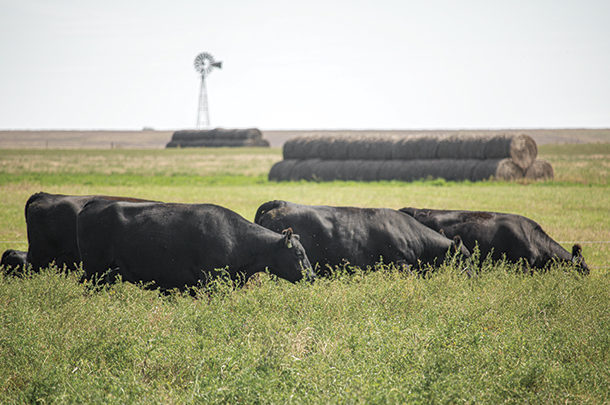As we move from winter to spring, here are some things you should keep in mind to help ensure your cows are set up for success before spring calving begins or to support the lactation demand of fall calves.
Quantify your nutrition program with body condition scores
It’s hard to make changes that will improve your bottom line if you aren’t measuring your results and comparing them over time. Nutritional shortcomings are often the leading cause of low productivity in a cow-calf enterprise, which is why examining your nutritional program with a critical eye is so important.
One way to do that is by using body condition scores (BCS) on a scale from 1 (emaciated) to 9 (obese) to assess whether your cows are getting adequate nutrition. Cows that calve in poor body condition (BCS less than 5) have greater days from calving to next heat, and they require more energy to recover condition than cows that calve at an ideal BCS of 6. Furthermore, calving in poor BCS can compromise optimal subsequent conception rates and reduce pre-weaning calf gain.
It’s easy to see why a solid nutrition program can benefit both your long- and short-term success. But it can be tricky to accurately score your herd’s body condition because you may not notice subtle changes that could indicate your cows aren’t getting proper nutrition. Body condition score is already a retroactive measurement, meaning you’re seeing changes to condition resulting from the previous nutrition program.
This is further confounded by a change in BCS being difficult to determine in cows that are seen daily by a producer. Invite someone over who doesn’t see your herd every day and ask for their score to get a more accurate representation of your herd’s health. BCS is still the best indicator of the nutrient status of a cow, and BCS at calving is the strongest indicator of subsequent reproductive success.
Reproductive success of a herd starts with proper development of replacement heifers. Heifers that efficiently gain weight quickly without becoming overconditioned reach puberty sooner and thus are breed-eligible sooner in their lifetime. This has positive implications for lifetime performance. Research results indicate that heifers calving in the first 22 days of the calving period will calve earlier and have higher pregnancy rates over their productive lifetime. They will also remain in the herd longer than heifers that calve later in the calving period.
Evaluate forage quality
As you know, not all forage has the same nutrient content. Sampling and testing forages for nutrient content is the best way to determine if your forage is meeting cows’ requirements and whether supplemental nutrients are needed.
As spring nears, remember that even if you’ve got plentiful grass in the pasture, that doesn’t necessarily ensure adequate nutrition. For example, oftentimes when grown under drought conditions, the nutritional value of grass declines without decreasing forage quantity.
Fine-tune your supplement strategy
A nutritional strategy that ensures spring-calving cows calve in proper BCS and supports the nutrient demands of fall-calving cows nursing calves is critical for profitable production. There are times when your cows may not receive the nutrition they need without adding supplements; this is especially true in the winter before grass green-up. Supplemental nutrients are important because a typical beef cow in late gestation requires more energy and protein, and this need further increases at calving to over 50% above maintenance requirements.
As a general rule, nutritional supplements are usually needed anytime grass is dormant. It’s common for producers to begin supplementing their feed when the warm-season grasses brown in late fall, which can help ensure the herd maintains optimum efficiency through the winter months. Oftentimes, producers come out of winter and stop supplementing too soon, resulting in a nutritional void until grazed forage is providing sufficient nutrients. Understanding grazed forage nutritive values compared to cow nutrient requirements is key to determining when to stop supplementing in the spring.
Protein and energy can be supplemented in many forms, including cubes, tubs, liquids, total mixed rations (TMRs) or blocks. Calculating the cost per unit of nutrient is the most economical way to value a supplement while considering logistics of feed delivery. Depending on the type of supplement and delivery frequency, protein supplementation can cost approximately 40 cents to 60 cents per cow per day. This is a relatively low cost to ensure conception and maximize pounds weaned. Strategically feeding cows to meet their dietary requirements using supplementation programs during mid- to late gestation and early lactation is a way to improve cow body composition, which can impact subsequent pregnancy rates and pounds of sellable product.
Develop a solid plan now
As winter fades and preparations begin for spring forage green-up, consider a precise nutrition program to position cows for optimal BCS to maximize productivity and efficiency. A new year is a great time to set goals and capitalize on opportunities to improve your profitability.
References omitted but are available upon request by sending an email to an editor.












